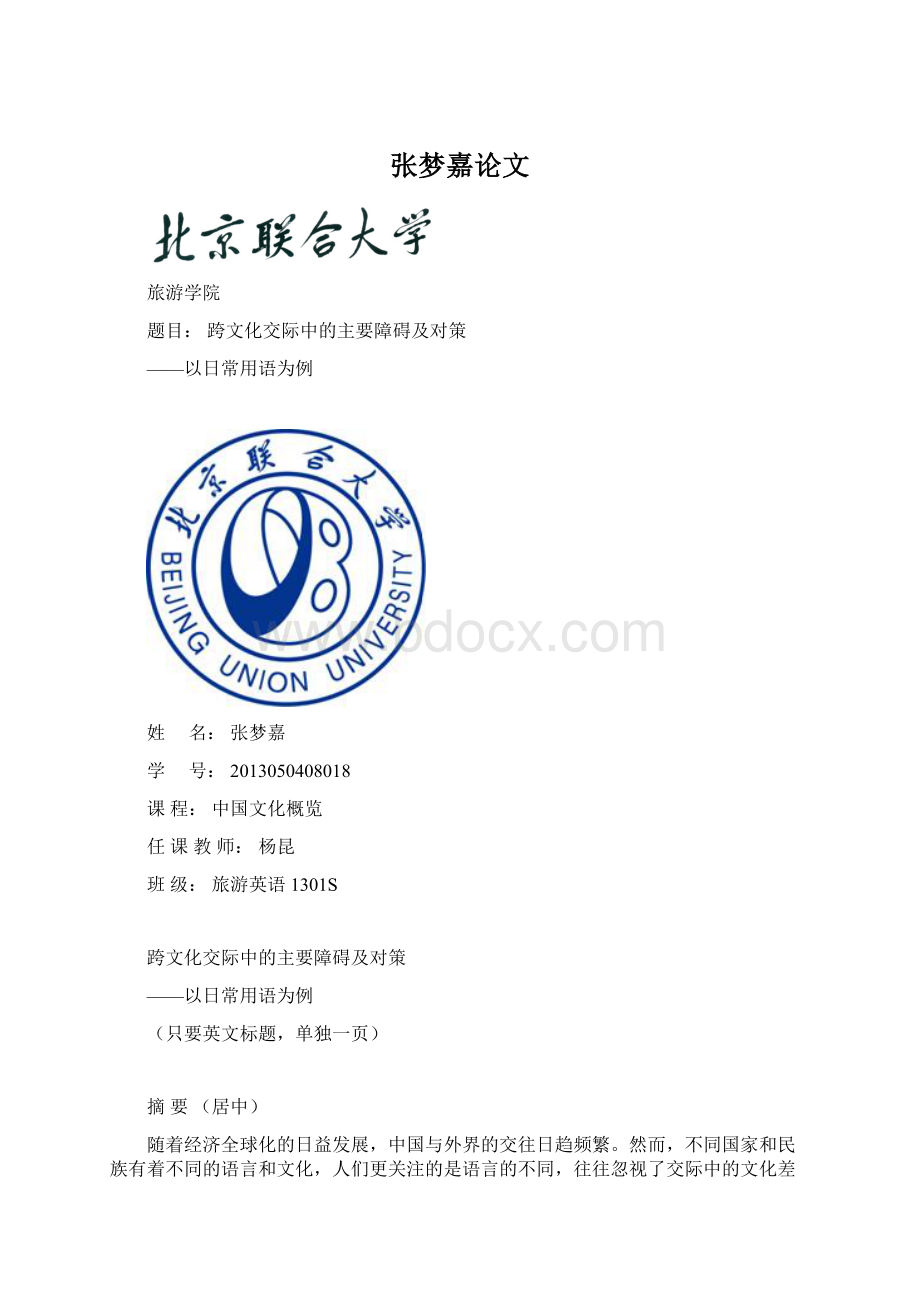张梦嘉论文Word文档格式.docx
《张梦嘉论文Word文档格式.docx》由会员分享,可在线阅读,更多相关《张梦嘉论文Word文档格式.docx(19页珍藏版)》请在冰豆网上搜索。

中国文化概览
任课教师:
杨昆
班级:
旅游英语1301S
跨文化交际中的主要障碍及对策
(只要英文标题,单独一页)
摘要(居中)
随着经济全球化的日益发展,中国与外界的交往日趋频繁。
然而,不同国家和民族有着不同的语言和文化,人们更关注的是语言的不同,往往忽视了交际中的文化差异。
跨文化交际中出现的种种问题不但会直接影响交际的顺利进行,甚至会产生误解和敌意,产生灾难性的的结果。
因此,总结跨文化交际中的种种障碍,分析障碍产生的原因,以及研究如何有效地客服交际障碍的策略,这不仅仅是需要中国的外语教育工作者不断研究和探索,更需要全社会的共同参与和关注,毕竟跨文化交际对促进国家和地区间的社会、经济、文化的交流具有极为重要的现实意义。
本文从跨文化交际的内涵和意义入手,分析和探讨了跨文化交际中存在的主要障碍,并通过对跨文化交际实例,特别是日常用语的分析,阐述了障碍产生的原因和消极影响,最后提出了如何克服这些障碍,实现有效的跨文化沟通的基本策略。
通过掌握这些策略,可以逐步提高我们的跨文化意识,成功地进行跨文化交际。
关键词:
跨文化交际;
障碍;
策略
(单独一页)
(英文摘要单独一页)
CONTENTS
Introduction:
1
1.InterculturalCommunication1
1.1Communication1
1.1.1DefinitionofCommunication1
1.1.2ComponentsofCommunication1
1.1.3CharacteristicsofCommunication………………………………………………….2
1.2Culture3
1.2.1DefinitionofCulture3
1.2.2ComponentsofCulture3
1.2.3CharacteristicsofCulture3
1.3InterculturalCommunication4
1.3.1DefinitionofInterculturalCommunication4
1.3.2TheDevelopmentofInterculturalCommunication5
1.3.3TheStudyofInterculturalCommunication5
2.ObstaclestoInterculturalCommunication6
2.1AssumingSimilarity7
2.1.1DefinitionofAssumingSimilarity…………………………………………………..7
2.1.2ThePerformanceofAssumingSimilarity…………………………………………..7
2.1.3TheFormingReasonofAssumingSimilarity………………………………………8
2.2Stereotypes9
2.2.1DefinitionofStereotypes9
2.2.2ThePerformanceofStereotypes9
2.2.3TheImpactofStereotypes10
2.3Ethnocentrism…………………………………………………………………………..11
2.3.1DefinitionofEthnocentrism……………………………………………………….11
2.3.2ThePerformanceofEthnocentrism………………………………………………..11
2.3.3TheImpactofEthnocentrism……………………………………………………...13
3.StrategiesforCopingWithTheObstacles……………………………………………….14
3.1KnowingYourself………………………………………………………………………14
3.1.1KnowYourCulture………………………………………………………………..14
3.1.2KnowYourPersonalAttitudes……………………………………………………..15
3.1.3KnowYourCommunicationStyle…………………………………………………15
3.2KnowingtheCulturalSettings………………………………………………………….16
3.2.1Timing……………………………………………………………………………...16
3.2.2PhysicalSetting……………………………………………………………………17
3.2.3Customs……………………………………………………………………………17
3.3DevelopingEmpathy…………………………………………………………………...18
3.3.1DefinitionofEmpathy……………………………………………………………..18
3.3.2HindrancestoEmpathy……………………………………………………………18
3.3.3ImprovingEmpathy………………………………………………………………..19
4.Conclusion20
Bibliography……………………………………….………………………………………22
Introduction(居中)
Wearenowinaworld,whichissometimesreferredtoasa“globalvillage”.Withtherapiddevelopmentofinternationaltrade,improvedtechnologiesofcommunicationandthetendencyofglobalization,moreandmoreexchangesaretakingplaceinternationallyinalmosteveryline,whichmaycallforabetterstudyoninterculturalcommunicationinordertohelpthoseinterculturalactivitiesresultinbettereffects.
(至少一页到两页,字数不够。
写选题意义,研究现状,你的研究方法)
.InterculturalCommunication
1.1.Communication
1.1.1.DefinitionofCommunication
Itisdifficulttofindasingledefinitionofhumancommunication.Beingconcernedwiththeinterculturaldimensionsofcommunication,weassenttothedefinitionadvancedbyRubinandStewart:
”Humancommunicationistheprocessthroughwhichindividuals—inrelationships,groups,organizations,andsocieties—respondtoandcreatemessagestoadapttotheenvironmentandoneanother(RubinandStewart1998).”
Communication—ourabilitytoshareourideasandfeelings—isthebasisofallhumancontacts.WhetherweliveinacityintheUSA,avillageinIndia,acommuneinIsrael,weallparticipateinthesameactivitywhenwecommunicate.Theresultsandthemethodsmightbedifferent,buttheprocessisthesame.
1.1.2.ComponentsofCommunication
Allcommunicationcontainssixbasiccomponents.Firstisthesource.Asourceisasenderofinformation.Heorshecouldsendamessagewithorwithoutknowinghisorheractionswerecommunication.
Thesecondcomponentisencoding,whichdescribestheproducingofasymbolicmessage.Encodingisaninternalactivityinwhichverbalandnonverbalsymbolsareselectedandarranged.Itistheprocessoftranslatinganalreadyconceivedideaintoamessageappropriatefortransmissiontoareceiver.
Thethirdcomponent,amessage,istheproductionofencoding.Themessageisasetofverbalandnonverbalsymbolsthatrepresentsthefeelingsandideasofthesender.Italsoincludessymbolicmessagesthatthesenderistotallyunawareofhavingsent.
Channelisthefourthcommunicationcomponent.Thechannelprovidesthatnecessaryconnectionbetweenthecommunicationparticipants.Theprimarychannelsaresoundandsight.Thedegreetowhichanindividualreliesononechanneloranotherisoftenaproductofculture.
Receiveristhefifthcomponent.Thereceiveristhepersonorpersonswhocomeintocontactwiththemessage.Receiversmaybethoseforwhomthesenderintendedortheymaybeotherswho,forwhateverreasons,comeintocontactwiththemessage.
Decodingisthesixthcomponent.Inthedecodingprocess,thereceiverinterpretswhatheorshebelievesthesourcemeantbythemessagetransmitted.Thisoperationisakintothesource’sactofencodingsinceitisalsoaninternalactivity—anactivityoftenreferredtoasinformationprocessing.
1.1.3.CharacteristicsofCommunication
Communicationisadynamicprocess.Itmeansthatcommunicationisanongoingactivity.Itislikeamotionpicture,notasinglesnapshot.Asinglewordoractiondoesnotstayfrozenwhenwecommunicate;
itisimmediatelyreplacedwithyetanotherwordoraction.Onceawordoranactionisemployed,itcannotberetracted.Whatissaidcannotbeunsaid.Andwhatisdonecannotbeundone.
Communicationissymbolic.Humansaresymbol-makingcreatures.Weareabletogenerate,receive,store,andmanipulatesymbols.Weemploysymbolstoshareourinternalstates.Ourwordsandactionsareothersetsofsymbolsthroughwhichweconveyourmessages,ideasandfeelingstootherpeople.
Communicationhasaconsequence.Thischaracteristicimpliesthatwhenwereceiveamessage,somethinghappenstous.Italsomeansthatallofourmessages,inonedegreeoranotherdoessomethingtosomeoneelse.Wecannotsendmessageswithoutinfluencingotherpeople.Thisisnotaphilosophicalormetaphysicaltheorybutabiologicalfact.Itisimpossiblenottorespondtothesoundsandactionsofothers.
1.2.Culture
1.2.1.DefinitionofCulture
TherearemorethanonehundreddefinitionsoftheEnglishwordcultureofferedbyresearchersfromdifferentperspectives.SamovarandPorterevolvedadefinitionfromtheperspectiveofinterculturalcommunication:
Cultureisthedepositofknowledge,experience,beliefs,values,attitudes,meanings,hierarchies,religion,notionoftime,roles,spatialrelations,conceptsoftheuniverse,andmaterialobjectsandpossessionsacquiredbyagroupofpeopleinthecourseofgenerationsthroughindividualandgroupstriving(SamovarandPorter1991).
Cultureismentalprogramming,ittellsusfromearlychildhoodwhatmatters,whattoprefer,whattoavoid,andwhattodo.Itgivesusassumptionsabouttheidealbeyondwhatindividualsmayexperience.Itestablishescodesforbehaviorandprovidesjustificationandlegitimizationforthatbehavior.
1.2.2.ComponentsofCulture
Inspiteofthelackofagreementononedefinitiononculture,mostscholars,Chineseandforeign,seemtoagreethatcultureincludesthreemajoraspects.AlmaneyandAlwansubmittedthreecategoriesofcultureelements:
Culturesmaybeclassifiedbythreelargecategoriesofelements:
artifacts(whichincludeitemsrangingfromarrowheadstohydrogenbombs,magiccharmstoantibiotic,torchestoelectriclights,andchariotstojetplanes);
concepts(whichincludesuchbeliefsorvaluesystemsasrightorwrong,Godandman,ethics,andthegeneralmeaningoflife);
andbehaviors(whichrefertotheactualpracticeofconceptsorbeliefs)(RogersandSteinfatt1999).
Thereisanexcellentexampleofhowthesethreeaspectsmightbereflectedwithinaculture.Whereasmoneyisconsideredanartifact,thevalueplaceduponitisaconcept,buttheactualspendingandsavingofmoneyisbehavior.
1.2.3.CharacteristicsofCulture
Cultureislearned.Cultureisnotsomethingwearebornwith.Frominfancyon,membersofaculturelearntheirpatternsofbehaviorandwaysofthinkinguntiltheyhavebecomeinternalized.Peoplelearntothink,act,feelandbelievewhattheircultureconsidersproper.Forinstance,humansneedfood.Butwhattoeat,when,whereandhowtoeatislearned.That’swhyweusechopstickswhilewesternerspreferknifeandfork,andwhywelikericewhileAmericanspreferbread.
Cultureissubjecttochange.Cultures,onceformed,arestable,butareatthesametimechangingwiththedevelopmentofhumansociety.Itseldomremainsconstant.Itisnotdifficultatallforustothinkofexamplesofhowsocialandhistoricaleventsbringchangesinourculture.ThefoundingofnewChina,theimplementationofthepolicyofopeningtotheoutsideworldandChina’sWTOentry,areallgoodexamples.
Cultureisinterrelated.Itmeansthatcultureiscomposedofinterrelatedfacets.Whenyoutouchoneplaceofaculture,everythingelseisaffected.TheoutbreakofSARSinspring2003inChinaisanillustrativeexample.Itmadeitseffectsfeltinmedicalsystems,tourism,lifestyle,familylife,governmentpolicies,environmentprotectionandmanyothers.
Cultureisinvisible.Mostofcultureishidden,likethepartoftheicebergunderwater.Cultureexistsinthesubconsciousmindofpeople.Peoplenotonlylearntheculturalbehaviors